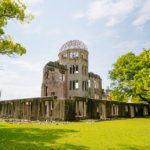Hiroshima Report 20235. The United States ■Nuclear-Weapon State
| Nuclear Disarmament | 24.2 Points | Full Points 109 | 22.2% |
| The U.S. is estimated to possess approximately 5,400 nuclear warheads, the second largest NWS next to Russia, and continues to reduce the number. While it called for Russia to establish a framework on nuclear arms control following the New START, the U.S. has not made any specific proposals for further reductions in nuclear weapons after New START. It released a Nuclear Posture Review (NPR), stating that the development of sea-launched nuclear cruise missiles (SLCM-N) would be discontinued, while plans to modernize nuclear forces would continue and the deployment of SLBMs with low-yield nuclear warheads would be maintained. The U.S. also stated that it would not adopt policies such as no first use of nuclear weapons or the sole purpose of nuclear weapons. The NPR also detailed policies and measures for nuclear risk reduction. The U.S. has not signed the TPNW. While the U.S. has not ratified the CTBT, it expressed its intention to make efforts toward a treaty’s entry into force. It remains the one of the most transparent NWS on nuclear issues. It has established and led the “International Partnership for Nuclear Disarmament Verification (IPNDV).” It voted in favor of the UNGA resolution on nuclear disarmament proposed by Japan. | |||
| Nuclear Non-Proliferation | 39 Points | Full Points 47 | 83.0% |
| Regarding the JCPOA from which the U.S. withdrew in 2018, it joined indirect negotiations with Iran and other countries concerned. However, they could not reach an agreement to reconstruct a deal in 2022. It abstained the UNGA Resolution on the Establishment of WMD-Free Zones in the Middle East, and did not participate in the Conference on the Establishment of WMD-Free Zones in the Middle East. The U.S. has proactively led the efforts to bolster nuclear non-proliferation, including contributions to the IAEA safeguards systems and implementation of stringent export controls. It acceded to the IAEA Additional Protocol with the provision for complementary access visits. The U.S. submitted a report based on the Guidelines for the Management of Plutonium to the IAEA. It continues to engage discussions with the IAEA regarding the implementation of safeguards on nuclear fuel for Australia’s nuclear-powered submarines, which is being promoted by Australia, the U.K. and the U.S. | |||
| Nuclear Security | 21 Points | Full Points 38 | 55.3% |
| The U.S. has ratified all nuclear security-related conventions and established a national implementation system for A/CPPNM. They announced that it plans to host an IPPAS mission in 2024. The last IPPAS mission was held in 2013. The U.S. is vigorously supporting other countries’ HEU minimization efforts. They announced that regulators have completed inspections of nuclear power plant cybersecurity programs in 2021. The U.S. participates in all INFCIRC initiatives and continues to contribute to the NSF. | |||






